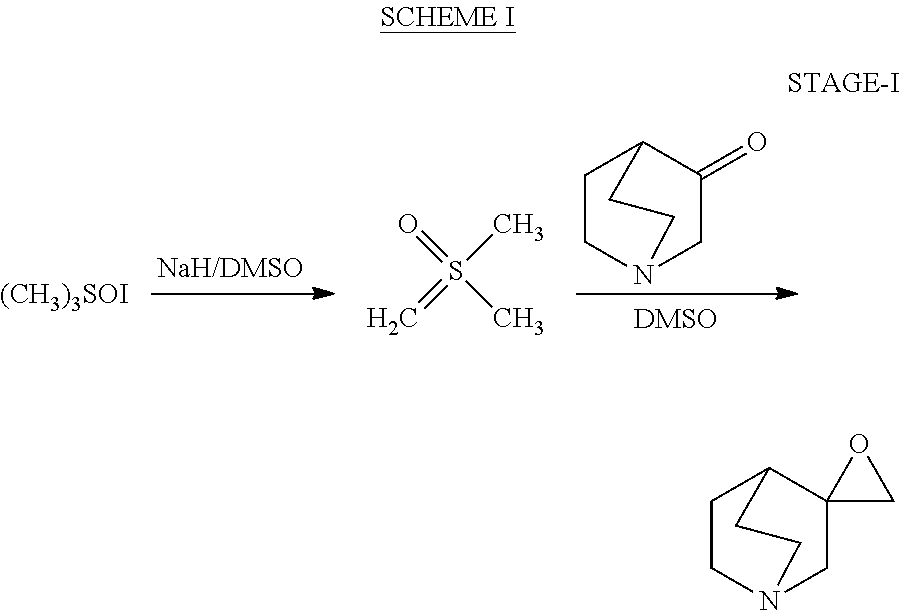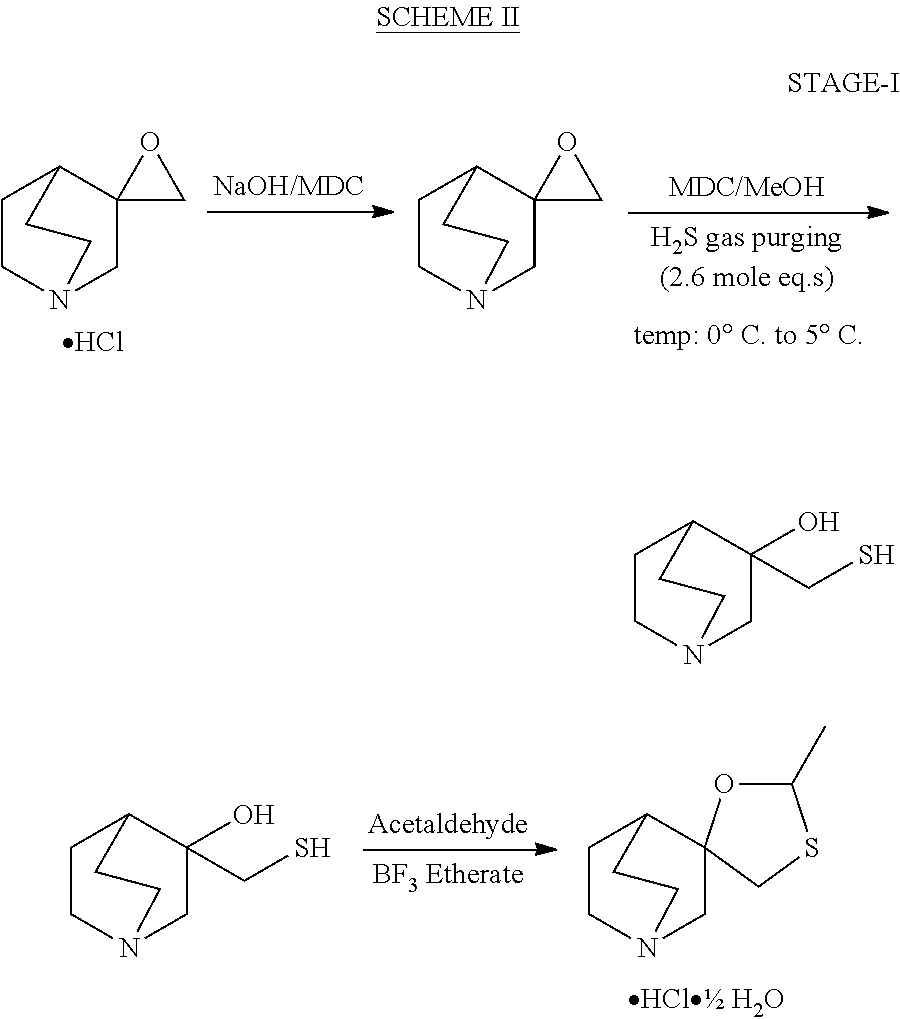Process for the preparation of cis-2-methylspiro (1,3-oxathiolane 5-3') quinuclidine
a technology of cis-2-methylspiro and quinuclidine, which is applied in the field of process for the preparation of cis-2-methylspiro (1,3oxathiolane 53 ') quinuclidine, can solve the problems of low yield of intermediate, lack of scalability, and requirement of an additional catalyst, and achieves a much shorter reaction time, high yield, and acceptable and inexpensive
- Summary
- Abstract
- Description
- Claims
- Application Information
AI Technical Summary
Benefits of technology
Problems solved by technology
Method used
Image
Examples
example i
Preparation of 3-hydroxy 3-mercapto methylquinuclidine
[0029]A solution of the epoxide of 3-methylene quinuclidine (100 g, 0.719 moles) in dichloromethane was cooled to a temperature between about 0 to 5° C. The solution was charged with methanol (100 ml). The mass was stirred for 10 to 15 minutes at this temperature range. To this cold solution hydrogen sulfide gas (50 g, 1.4 mol) was passed and after the passing was complete, the reaction was continued at this temperature for 2 to 3 hours, monitored by gas chromatography, whereupon the peak of epoxide of 3-methylene quinuclidine disappeared. After completion of the reaction, a dichloromethane solution of 3-hydroxy 3-mecapto methylquinuclidine in methanol was obtained. This solution was used for the next step.
example ii
[0030]A solution of acetaldehyde (250 ml) in dichloromethane (1000 ml) was cooled to 0 to 5° C. To this solution was charged the 3-hydroxy-3-mecapto methylquinuclidine solution (100 g epoxide equivalent) prepared in Example I. Boron trifluoride etherate (320 ml) was added simultaneously drop wise over 2 to 3 hours. After completion of the addition, the reaction mass was stirred at 20 to 25° C. for an additional 3 hours. The reaction mass was cooled to 0 to 5° C. A solution of sodium hydroxide (150 g dissolved in 150 ml water) was charged to the solution and the pH of the mixture was adjusted to 12 to 14. The layers were separated. The dichloromethane layer was washed with 5% sulfuric acid solution (500 ml). The product was extracted again in di-isoproyl ether with basification of the aqueous layer to pH 10 to 12. The organic layer containing the product was separated and the base converted to a hydrochloride salt by acidification with IPA / HCl solution to yield 65 g of the racemic ce...
example iii
[0031]Dichloromethane (200 ml) was charged in a vessel. To this was charged (10.0 g) of racemic mixture of cis / trans cevimeline having a 65:35 ratio of cis:trans isomer. The reaction mass was stirred for 10 to 15 minutes at 20 to 25° C. 1.0 ml of IPA was charged to the reaction mass. The reaction mass was cooled to −5 to 0° C. Anhydrous titanium tetrachloride (7.0 ml) was charged to the reaction mass over 5 to 10 minutes. After addition, stirring was continued for 18 to 24 hours at 20 to 30° C. After completion of the reaction, the reaction mass was cooled to 0 to 5° C. Process water (100 ml) was added and the mass was stirred for 10 to 15 minutes. The layers were separated. The dichloromethane layer was washed with 5% sulfuric acid (2×50 ml) and the layers separated. To the combined aqueous layer, di-isopropyl ether (100 ml) was charged and the pH of the solution adjusted 10 to 12. The layers were separated and the aqueous portion re-extracted with di-isopropyl ether (50 ml). The c...
PUM
| Property | Measurement | Unit |
|---|---|---|
| temperature | aaaaa | aaaaa |
| temperature | aaaaa | aaaaa |
| temperature | aaaaa | aaaaa |
Abstract
Description
Claims
Application Information
 Login to View More
Login to View More - R&D
- Intellectual Property
- Life Sciences
- Materials
- Tech Scout
- Unparalleled Data Quality
- Higher Quality Content
- 60% Fewer Hallucinations
Browse by: Latest US Patents, China's latest patents, Technical Efficacy Thesaurus, Application Domain, Technology Topic, Popular Technical Reports.
© 2025 PatSnap. All rights reserved.Legal|Privacy policy|Modern Slavery Act Transparency Statement|Sitemap|About US| Contact US: help@patsnap.com



